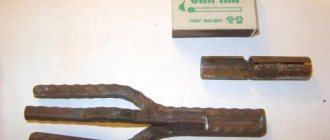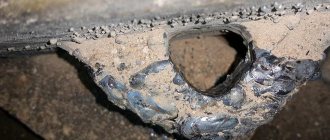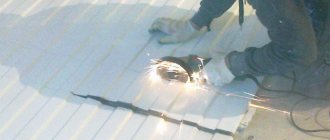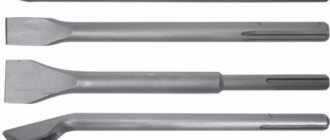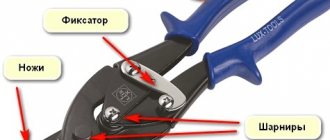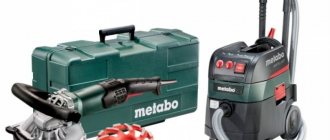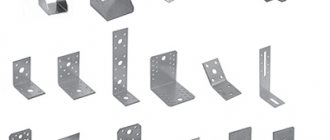To perform work related to manual arc welding of metal parts, you need not only a welding machine, but also additional accessories for it. They ensure correct assembly of the electrical circuit, are responsible for the reliability of contacts and create comfortable and safe conditions for the welder. These primarily include conductive cables, clamps and electrode holders. Such accessories are sold as part of the welder kit or purchased additionally. In any case, a novice master needs to know their purpose, main types and features of application.
Electric holder
The welding machine holder is designed to hold the electrode, supply voltage to it and control its position in the welding zone. It has simple but important requirements:
- reliable fixation of welding rods of various diameters in positions convenient for the welder;
- tight electrical contact;
- simple design ensuring long-term use of the electrode holder;
- ergonomics and safety.
All of the above qualities can be realized in different ways.
Device
Let us briefly consider the design of the electrode holder. Several important factors depend on the design of the device:
- quality of welded joints;
- master's labor productivity;
- convenience and safety of work.
inexpensive electrode holder
A standard type holder is a tool consisting of several parts: body, clamp, handle, moving parts. But different species may have some structural features . More details below.
Types of welding holders
Welding electric holders are classified according to their design and principle of electrode gripping. Almost all of them have a comfortable handle and a mechanical rod lock.
Clothespin holder
This type of holder uses a spring or lever mechanism to clamp the electrode. Their contact surfaces are made in the form of gear parts, allowing the rod to be quickly and firmly fixed in any position convenient for the welder. Most models have a dielectric outer coating, which increases safety for personnel and eliminates unintentional sparking. The main disadvantage of this design is the insufficient grip reliability when the spring weakens and the contacts wear out.
Fork trident
Such an electric holder can no longer be found in specialized stores, but old-school welders continue to use it. The electrode is held here due to the springing action of three steel rods welded together into a single structure vaguely reminiscent of a fork. This device is easily made by hand, but has a number of serious disadvantages:
- the presence of unprotected surfaces under voltage;
- difficulty in extracting the cinder;
- low ease of use.
Collet holder
Holders with a collet principle of electrode clamping have a slightly more complex design, which requires high precision in the manufacture of parts. They have found application in torches used for argon arc welding. They have a narrow scope of use and are quite expensive.
Non-burning holder
This type of holder consists of a handle and a contact pin. Before use, the electrode is welded to its end, which makes it possible to almost completely use the metal of the rod during the welding process. Devices of this design are in demand when working with expensive consumables.
Screw holder
The screw electric holder for welding inverter is highly popular among professionals. It most reliably fixes electrodes of any cross-section due to the threaded method of pressing. Products of this design have virtually no exposed areas, and this has a positive effect on safety. The need to periodically turn the screw slightly increases the time of fixing the rods, which is compensated by the strength of contact and ease of operation.
What is important when choosing a holder
An electric welder holds this device in his hands for a significant part of his working time, so his choice should be approached with maximum responsibility. An experienced master will definitely pay attention to the following points:
- weight, dimensions, ergonomic qualities of the handle;
- compliance of the product labeling with the range of current used in the upcoming work;
- possibility of reliable fixation of electrodes of the required diameter;
- ease of fastening the rod at different angles;
- quality of manufacture of live parts and clamping devices;
- the degree of outer coating of the holder with insulating materials;
- model cost.
Advice! For off-site work, it is advisable to always have a backup power holder.
How not to buy a low-quality holder for a welding machine
Live parts of a quality device must be made of copper and protected with insulating material. Some unscrupulous companies manufacture live parts from steel and then coat them with copper. Thus, the parts become very hot and burn quickly.
They look like copper and it is difficult for a non-professional to visually distinguish them from “all-copper” parts. There is one surefire way that requires a magnet. It is necessary to bring a magnet to the part being tested; if the parts are magnetic, then they are made of steel.
Copper jaws of the holder
Brief overview of popular holder models
Welding holders do not belong to the category of high-tech equipment. For a reasonable price, you can easily find a comfortable and durable model. To make the right choice, it is enough to know several brands from trusted manufacturers.
ESAB Handy 200
This model from the respected Swedish company ESAB is highly popular among professionals and amateurs. It is best suited for using electrodes with a diameter of 2 to 4 mm and is designed for a welding current of 200 amperes. Its weight of only 550 grams will not cause fatigue during the work shift. The screw clamp ensures quick replacement and reliable retention of rods fixed at an angle of 90° and 45°. Complete insulation of live parts guarantees the absence of accidental leaks. You can purchase the product for 500-600 rubles.
Sibrtech 91455
A domestic pincer-type model with a powerful spring costs only 200-250 rubles. It provides quick replacement of electrodes and their fixation in any direction. There are no restrictions on diameter. Current-carrying parts operate reliably at currents of up to 500 A. The product weighs less than 300 g. It has an ergonomic textured handle and a convenient clamp opening lever. The covering is made of durable insulating material.
Cedar Germany type 300A
Another Russian-made model with a pliers clamp, made of brass with a plastic coating. It weighs about 400 grams and is designed for welding current up to 300 amperes. The electrode can be easily installed in one of four possible positions. The handle does not slip in the hand and is not afraid of high temperature exposure. The price of a product of this brand starts from 300 rubles.
Welding accessories
An inverter, a holder and an electrode are not yet electric welding; additional accessories are needed to perform a faster and better range of tasks. Such devices as: pouches; tees; extension cords; drying ovens for equipment; hoods: magnetic corners and clamps can make working conditions more comfortable and safer. When replacing the protective glass with an automatic “chameleon”, which changes the amount of transparency depending on the brightness of the arc, you don’t have to be afraid to “grab the hare”, but also do the job better because the glass will automatically select the required light transmission, ensuring optimal visibility of the weld. On our website you can select all the necessary accessories for welding work, from a transformer to an autonomous power station to power it.
Making your own electrode holder
The easiest way to make a trident-shaped holder with your own hands from available materials . For this, steel wire of round or variable cross-section with a diameter of about 8 mm is used. Three pieces about 20-25 cm long are cut from it. Two of them are slightly bent and welded together with their lower ends so that the pieces are located in the same plane, and their upper ends form the outer teeth of the fork.
The third piece is made a little shorter than the rest. It is also given a slight bend, orienting it in a plane perpendicular to the first two blanks.
Welding is carried out in such a way that the bare end of the electrodes most often used in the work elastically fits into the gap formed with some force.
For a reliable and tight connection of the welding cable with the resulting structure, its end is exposed by 6-8 centimeters and tightly wrapped with small-diameter steel wire. The resulting tip is welded to the long lower ends of the outer rods of the holder. The handle is made from a piece of rubber hose, an elastic plastic tube or a dielectric sheath of a wire of the required diameter, pulling it from the back. The manufacturing process is clearly demonstrated in the following video.
Ground clamp
For proper operation of the electrical circuit, the parts being welded must be securely connected to ground. Only in this case will a high-quality seam be obtained, and the welder will be protected from electric shock. In this case, the contact function is intended to be performed by clamping the mass. Standard accessories do not always correspond to the assigned tasks, so experienced craftsmen try to select the equipment themselves. The most important characteristics of electrical clamps are:
- maximum current flow;
- sufficient contact density;
- ability to support the weight of the cable;
- terminal opening angle.
Main types of clamps
The clamping arrangement may be different. In difficult situations they behave differently. This should inevitably be taken into account when purchasing.
Crocodile
This type of welding clamp has a powerful spring and teeth for easy engagement. They are installed and removed with one movement of the hand.
Their advantages include:
- ease of use;
- easy adaptation to parts of any shape;
- high degree of opening.
They also have disadvantages:
- gradual weakening of the spring;
- not always reliable contact.
Magnetic clamp
This design requires the presence of a strong permanent magnet and a terminal for connecting the cable.
This offers compelling advantages:
- simplicity and durability;
- possibility of attachment to parts of any shape and size;
- use in hard-to-reach places;
- no moving parts;
- large contact area.
But we must not forget about the disadvantages:
- low reliability of fastening to parts with a small contact surface;
- sensitivity to pollution;
- demagnetization at high temperatures;
- impossibility of application on stainless steel, cast iron and non-ferrous metals.
Clamp
Fastening the ground cable using a screw mechanism is not so widespread and is most often used in special conditions.
Its advantages:
- exceptionally high connection reliability;
- wide contact area.
Flaws:
- significant dimensions of the product;
- labor-intensive fastening.
Magnetic corners
Magnetic angles are very practical and can be of great help to the welder, especially if he is working without an assistant.
Such devices can be of several types in configuration: triangular, pentagonal, reminiscent of a trapezoid. Their application in practice is simple, just take the required magnet, install it on a horizontal plane and attach a metal rod to the edge; it will be fixed in the tilt position of the magnetic edge. So, for example, you can easily, by aligning the prepared sections at right angles, assemble the frame, align it, eliminating any distortions that have arisen by taking diagonal measurements, and fix it by welding. Also, with the help of these corners, you can fix the vertical posts without fear of their deviation from the vertical. Magnets are produced in various configurations and sizes, which are divided into series. The side edge must indicate the slope of the edge in degrees.
Another convenient device is a mass holder.
The principle of operation of a magnetic contact is not difficult to understand. It is a magnet for connecting a second wire to the workpiece to create a looped circuit (the first one will be on the electrode). Such a wire is usually called a “mass”. The ground wire is firmly connected to the magnet, then touch-connected to the workpiece. Connecting the secondary wire in this way has its advantages and disadvantages.
Advantages:
- it is possible to create a circuit as close as possible directly to welding, which reduces the resistance to current as it moves through the metal;
- quick connection and connections with the ground cable blank;
- does not require additional maintenance, as it has a simple design.
Flaws:
- a clean surface is required to establish contact;
- low mechanical strength of fastening;
- dependence of the magnet size on the current strength;
- A large mounting area is required;
- unacceptable when welding narrow-profile or small-sized parts;
- decrease in magnetic properties over time and heating.
- high price. The cost of magnets for a contact of 200 - 300 A will cost approximately 500 - 600 rubles.
Welding machine Resanta – SAI 250
This device is one of the cheapest and most powerful in its line. The head office of Resant is located in Latvia and the device is manufactured in China under license. The inverter is positioned as a professional one, producing electrodes with an arc power of 150 to 250 A (electrode diameter 3-6 mm). Available complete with all accessories: cable, holder and earth clamp.
"Resanta" produces a line of inverters in 160A, 190A. Separately, you can dwell on the electrode holder for the resanta welding machine - this device, made of especially strong and heat-resistant plastic, has good reviews from users.
Welding cable
Voltage is supplied to the welding site and connection to the ground of the parts being connected is carried out using welding cables. They in most cases have a single conductor of round cross-section and are usually terminated with standard terminals. They are subject to increased requirements:
- mechanical strength and resistance to chemically active substances;
- possibility of repeated twisting and straightening;
- high flexibility;
- immunity to dirt and moisture.
The most widely used flexible cable is the KG brand. It is designed to operate with direct current up to 1 kV or with alternating current voltage up to 660 V and frequency up to 400 Hz. It has a number of varieties:
- KG-HL, resistant to frost down to -60°C;
- KG-T, designed for tropical climates;
- KGN equipped with non-combustible insulation;
- KG-KOG, which is particularly flexible.
Cable KG 1x25
The KOG brand cable is suitable for arc welding, semi-automatic or automatic welding with direct current up to 700 V or with alternating current voltage up to 220 V and frequency up to 50 Hz. Its varieties are also focused on different environmental temperatures.
Cable KOG 1 1x16
In addition to single-core cables, the following are widespread:
- two-core wires for pulse welding and cutting;
- three-core cables used in various types of automatic welding.
The maximum parameters of the current passing through the cable are directly related to the material used and the cross-sectional area. When choosing the required section, you should use special tables. For a household inverter operating from a 220-volt network, a single-core copper wire of 6.7 mm2 is suitable, and for powerful automatic units, 35.6 or 47.2 sq.mm are more often used.
Now about the addition to inverters
These are autonomous power sources. If you conduct a short review of welding generators, manufacturers present their products as a generator, an autonomous power supply, a power plant, don’t let the name confuse you - they are one and the same. Autonomous power supplies are divided into types based on the engine: gasoline; diesel; or a gas generator. Which, in turn, are divided by power and type of cooling - air-cooled; liquid and mixed. Now you need to understand how to use it.
If it is clear with the engine and fuel, then the type of cooling is worth stopping; as a rule, air-cooled engines are designed for a short operating time, especially at maximum power and after a short operating time, they require a rest to cool down. Liquid-cooled engines are designed for continuous operation and their operation is limited only by fuel resources at rated power use. Gas fuel engines are the most economical, but also the most expensive, slightly cheaper than diesel engines, the cheapest and most common are gasoline 2-stroke or 4-stroke single-cylinder, less often two-cylinder.
So which generator should you choose for welding? The fact is that the indicated power of the generator and welding do not match, namely, the transformer uses an active current load in the form of an arc and low voltage, while for generators the power is calculated in the usual way, the constant voltage is multiplied by the current. So, since the generator produces a stable voltage, sharp starting surges or voltage fluctuations during an arc break are perceived by the generator protection as a network malfunction and a shutdown occurs. This is especially true with modern small-sized inverters. For this reason, if you plan to use the generator for welding, then it is necessary to select its power 10-15% more than indicated on the inverter. Giving accurate tables and recommendations is not a rewarding task, because... Each device is individual. If there is a need to purchase separate units, then it is best not to be lazy. take the inverter with you to the store and test it when purchasing, choosing the “right” generator that will work normally with it in tandem.
Combined generators
To avoid such problems, dual or combined generators and inverters have been developed.
Such machines are distinguished by already selected characteristics and when purchasing, you can accurately focus on the specified parameters and power. In addition, the generator can be used in addition to welding for other electricity consumers. Attention! Manufacturers warn that it is imperative to use a dual machine in welding mode without connecting additional power sources, especially power tools, since this load is reactive, and the combined use of reactive and active loads from one source can damage the unit’s protection system.
The industry produces a large number of self-generators of varying power and cost; here is one of them:
The device of the Italian brand is the Mosa MSG CHOPPER welding generator. The generator has one of the best characteristics of a combination of autonomous engine mode and generator characteristics in the form of welding current. The generator allows the use of electrodes with a current of up to 200 A. of various types: ordinary, stainless, with alloyed additives. It is designed for long-term operation in welding mode, and a 60% coefficient of continuous switching (continuous switching time) means that the device can operate for 10 minutes - 6 work, 4 rest, at maximum current (in cutting mode).
Below are the characteristics of the generator
| Power, R nom, kW: | 1, 8 |
| Power, Rmax, kW: | 2 |
| Voltage, UB: | 230 V |
| Number of phases: | 1 |
| Start: | manual |
| Execution: | in a casing |
| Type of current: | constant |
| Welding current, I nom, A.: | 165 |
| Welding current, I min, A.: | 50 |
| Electric/wire diameter: | 2.0 – 3.5 mm |
| Fuel consumption at I rated: | 1.5 l/h |
| Fuel tank, l: | 3 |
| Degree of protection: | IP 23 |
| Noise level: | 77 dB |
| engine's type | Petrol |
| Manufacturer: | MOSA |
| Cooling: | air |
| Engine speed rpm: | 6000 |
| Dimensions (AxBxS) | 570x 300x410 |
| Weight: | 29.5 kg |
| Manufacturer (brand): | Italy |
| Guarantee: | 1 year. |
| Price: | RUB 138,739 |
| Attention Bearing Buyers Dear customers, send your questions and requests for the purchase of bearings and components by email or call now: Delivery of bearings throughout the Russian Federation and abroad. Bearing catalog on the website |
Attention Bearing Buyers
Dear customers, send your questions and requests for the purchase of bearings and components by email or call now: +7 [email protected] Delivery of bearings in the Russian Federation and abroad. Bearing catalog on the website
themechanic.ru
Connecting cables
When connecting a cable to welding equipment, special tips are usually used to ensure reliable contact and protection from accidental contact. The wire must comply with the operating parameters of the welding machine. Particular attention is paid to maintaining polarity. When connecting two wires, it is necessary to use crimping followed by insulation.
In most cases, the standard cables sold with the inverter are, for a number of reasons, shorter than the technician would like. Although welding equipment manufacturers usually do not impose restrictions on their length, the welding lead extension must be used with extreme care. It is important to make sure that the added section does not lead to a critical decrease in voltage and welding current.
